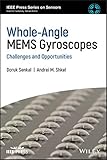Whole-angle MEMs gyroscopes : challenges and opportunities / Doruk Senkal, Andrei M. Shkel.
By: Senkal, Doruk [author.] .
.
Contributor(s): Shkel, Andrei [author.] .
.
Material type:  BookSeries: IEEE Press series on sensors.Publisher: Hoboken, New Jersey : Piscataway, NJ : John Wiley & Sons, Inc. ; IEEE Press, [2020]Edition: First edition.Description: 1 online resource (xiv, 153 pages) : illustrations (chiefly color).Content type: text Media type: computer Carrier type: online resourceISBN: 9781119441908; 1119441900; 9781119441922; 1119441927; 1119441862; 9781119441861.Subject(s): Gyroscopes
BookSeries: IEEE Press series on sensors.Publisher: Hoboken, New Jersey : Piscataway, NJ : John Wiley & Sons, Inc. ; IEEE Press, [2020]Edition: First edition.Description: 1 online resource (xiv, 153 pages) : illustrations (chiefly color).Content type: text Media type: computer Carrier type: online resourceISBN: 9781119441908; 1119441900; 9781119441922; 1119441927; 1119441862; 9781119441861.Subject(s): GyroscopesIncludes bibliographical references and index.
"Coriolis Vibratory Gyroscopes (CVGs) can be divided into two broad categories based on the gyroscope's mechanical element: (Type 1) degenerate mode gyroscopes, which have x-y symmetry, and (Type 2) non-degenerate mode gyroscopes, which are designed intentionally to be asymmetric in x and y modes. Currently, non-degenerate mode gyroscopes fulfill the needs of a variety of commercial applications, such as tilt detection, activity tracking, and gaming. However, when it comes to inertial navigation, where sensitivity and stability of the sensors are very important, commercially available MEMS sensors fall short by three orders of magnitude. Degenerate mode gyroscopes on the other hand, have a number of unique advantages compared to non-degenerate vibratory rate gyroscopes, including higher rate sensitivity, ability to implement whole-angle mechanization with mechanically unlimited dynamic range, exceptional scale factor stability, and a potential for self-calibration. For this reason, as the MEMS gyroscope development is reaching maturity, the Research and Development focus is shifting from high-volume production of low-cost non-degenerate mode gyroscopes to high performance degenerate mode gyroscopes. This paradigm shift in MEMS gyroscope research and development creates a need for a reference book to serve both as a guide and an entry point to the world of degenerate mode gyroscopes"-- Provided by publisher.
Cover -- Title Page -- Copyright Page -- Contents -- List of Abbreviations -- Preface -- About the Authors -- Part I Fundamentals of Whole-Angle Gyroscopes -- Chapter 1 Introduction -- 1.1 Types of Coriolis Vibratory Gyroscopes -- 1.1.1 Nondegenerate Mode Gyroscopes -- 1.1.2 Degenerate Mode Gyroscopes -- 1.2 Generalized CVG Errors -- 1.2.1 Scale Factor Errors -- 1.2.2 Bias Errors -- 1.2.3 Noise Processes -- 1.2.3.1 Allan Variance -- 1.3 Overview -- Chapter 2 Dynamics -- 2.1 Introduction to Whole-Angle Gyroscopes -- 2.2 Foucault Pendulum Analogy -- 2.2.1 Damping and Q-factor
2.2.1.1 Viscous Damping -- 2.2.1.2 Anchor Losses -- 2.2.1.3 Material Losses -- 2.2.1.4 Surface Losses -- 2.2.1.5 Mode Coupling Losses -- 2.2.1.6 Additional Dissipation Mechanisms -- 2.2.2 Principal Axes of Elasticity and Damping -- 2.3 Canonical Variables -- 2.4 Effect of Structural Imperfections -- 2.5 Challenges of Whole-Angle Gyroscopes -- Chapter 3 Control Strategies -- 3.1 Quadrature and Coriolis Duality -- 3.2 Rate Gyroscope Mechanization -- 3.2.1 Open-loop Mechanization -- 3.2.1.1 Drive Mode Oscillator -- 3.2.1.2 Amplitude Gain Control -- 3.2.1.3 Phase Locked Loop/Demodulation
3.2.1.4 Quadrature Cancellation -- 3.2.2 Force-to-rebalance Mechanization -- 3.2.2.1 Force-to-rebalance Loop -- 3.2.2.2 Quadrature Null Loop -- 3.3 Whole-Angle Mechanization -- 3.3.1 Control System Overview -- 3.3.2 Amplitude Gain Control -- 3.3.2.1 Vector Drive -- 3.3.2.2 Parametric Drive -- 3.3.3 Quadrature Null Loop -- 3.3.3.1 AC Quadrature Null -- 3.3.3.2 DC Quadrature Null -- 3.3.4 Force-to-rebalance and Virtual Carouseling -- 3.4 Conclusions -- Part II 2-D Micro-Machined Whole-Angle Gyroscope Architectures -- Chapter 4 Overview of 2-D Micro-Machined Whole-Angle Gyroscopes
4.1 2-D Micro-Machined Whole-Angle Gyroscope Architectures -- 4.1.1 Lumped Mass Systems -- 4.1.2 Ring/Disk Systems -- 4.1.2.1 Ring Gyroscopes -- 4.1.2.2 Concentric Ring Systems -- 4.1.2.3 Disk Gyroscopes -- 4.2 2-D Micro-Machining Processes -- 4.2.1 Traditional Silicon MEMS Process -- 4.2.2 Integrated MEMS/CMOS Fabrication Process -- 4.2.3 Epitaxial Silicon Encapsulation Process -- Chapter 5 Example 2-D Micro-Machined Whole-Angle Gyroscopes -- 5.1 A Distributed Mass MEMS Gyroscope -- Toroidal Ring Gyroscope -- 5.1.1 Architecture -- 5.1.1.1 Electrode Architecture
5.1.2 Experimental Demonstration of the Concept -- 5.1.2.1 Fabrication -- 5.1.2.2 Experimental Setup -- 5.1.2.3 Mechanical Characterization -- 5.1.2.4 Rate Gyroscope Operation -- 5.1.2.5 Comparison of Vector Drive and Parametric Drive -- 5.2 A Lumped Mass MEMS Gyroscope -- Dual Foucault Pendulum Gyroscope -- 5.2.1 Architecture -- 5.2.1.1 Electrode Architecture -- 5.2.2 Experimental Demonstration of the Concept -- 5.2.2.1 Fabrication -- 5.2.2.2 Experimental Setup -- 5.2.2.3 Mechanical Characterization -- 5.2.2.4 Rate Gyroscope Operation -- 5.2.2.5 Parameter Identification
Description based on online resource; title from digital title page (viewed on June 24, 2020).
John Wiley and Sons Wiley Frontlist Obook All English 2020


There are no comments for this item.